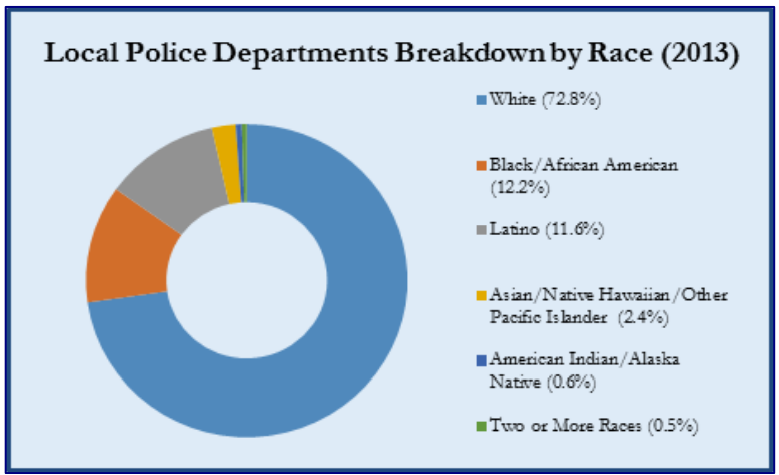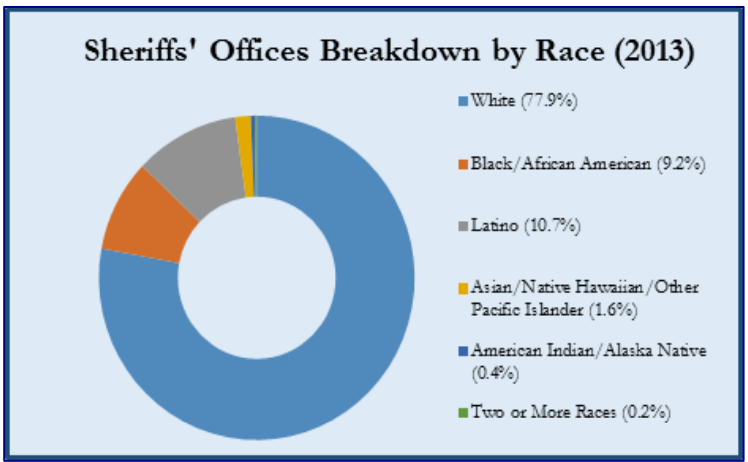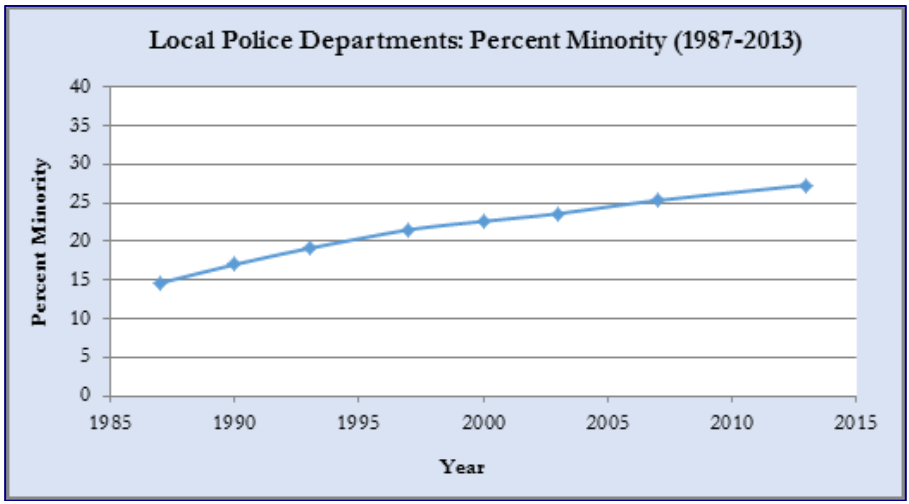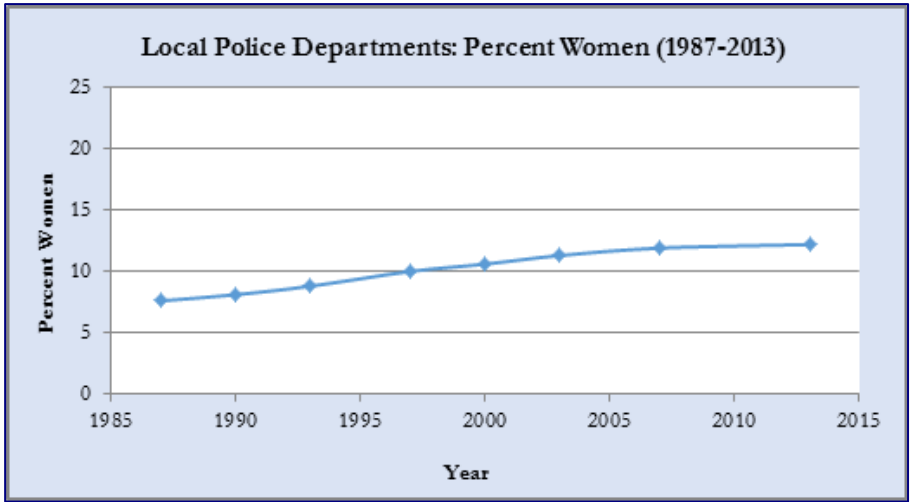1.5: Changes in Make-up of Administration of Justice Agencies
- Page ID
- 16088
\( \newcommand{\vecs}[1]{\overset { \scriptstyle \rightharpoonup} {\mathbf{#1}} } \)
\( \newcommand{\vecd}[1]{\overset{-\!-\!\rightharpoonup}{\vphantom{a}\smash {#1}}} \)
\( \newcommand{\id}{\mathrm{id}}\) \( \newcommand{\Span}{\mathrm{span}}\)
( \newcommand{\kernel}{\mathrm{null}\,}\) \( \newcommand{\range}{\mathrm{range}\,}\)
\( \newcommand{\RealPart}{\mathrm{Re}}\) \( \newcommand{\ImaginaryPart}{\mathrm{Im}}\)
\( \newcommand{\Argument}{\mathrm{Arg}}\) \( \newcommand{\norm}[1]{\| #1 \|}\)
\( \newcommand{\inner}[2]{\langle #1, #2 \rangle}\)
\( \newcommand{\Span}{\mathrm{span}}\)
\( \newcommand{\id}{\mathrm{id}}\)
\( \newcommand{\Span}{\mathrm{span}}\)
\( \newcommand{\kernel}{\mathrm{null}\,}\)
\( \newcommand{\range}{\mathrm{range}\,}\)
\( \newcommand{\RealPart}{\mathrm{Re}}\)
\( \newcommand{\ImaginaryPart}{\mathrm{Im}}\)
\( \newcommand{\Argument}{\mathrm{Arg}}\)
\( \newcommand{\norm}[1]{\| #1 \|}\)
\( \newcommand{\inner}[2]{\langle #1, #2 \rangle}\)
\( \newcommand{\Span}{\mathrm{span}}\) \( \newcommand{\AA}{\unicode[.8,0]{x212B}}\)
\( \newcommand{\vectorA}[1]{\vec{#1}} % arrow\)
\( \newcommand{\vectorAt}[1]{\vec{\text{#1}}} % arrow\)
\( \newcommand{\vectorB}[1]{\overset { \scriptstyle \rightharpoonup} {\mathbf{#1}} } \)
\( \newcommand{\vectorC}[1]{\textbf{#1}} \)
\( \newcommand{\vectorD}[1]{\overrightarrow{#1}} \)
\( \newcommand{\vectorDt}[1]{\overrightarrow{\text{#1}}} \)
\( \newcommand{\vectE}[1]{\overset{-\!-\!\rightharpoonup}{\vphantom{a}\smash{\mathbf {#1}}}} \)
\( \newcommand{\vecs}[1]{\overset { \scriptstyle \rightharpoonup} {\mathbf{#1}} } \)
\( \newcommand{\vecd}[1]{\overset{-\!-\!\rightharpoonup}{\vphantom{a}\smash {#1}}} \)
\(\newcommand{\avec}{\mathbf a}\) \(\newcommand{\bvec}{\mathbf b}\) \(\newcommand{\cvec}{\mathbf c}\) \(\newcommand{\dvec}{\mathbf d}\) \(\newcommand{\dtil}{\widetilde{\mathbf d}}\) \(\newcommand{\evec}{\mathbf e}\) \(\newcommand{\fvec}{\mathbf f}\) \(\newcommand{\nvec}{\mathbf n}\) \(\newcommand{\pvec}{\mathbf p}\) \(\newcommand{\qvec}{\mathbf q}\) \(\newcommand{\svec}{\mathbf s}\) \(\newcommand{\tvec}{\mathbf t}\) \(\newcommand{\uvec}{\mathbf u}\) \(\newcommand{\vvec}{\mathbf v}\) \(\newcommand{\wvec}{\mathbf w}\) \(\newcommand{\xvec}{\mathbf x}\) \(\newcommand{\yvec}{\mathbf y}\) \(\newcommand{\zvec}{\mathbf z}\) \(\newcommand{\rvec}{\mathbf r}\) \(\newcommand{\mvec}{\mathbf m}\) \(\newcommand{\zerovec}{\mathbf 0}\) \(\newcommand{\onevec}{\mathbf 1}\) \(\newcommand{\real}{\mathbb R}\) \(\newcommand{\twovec}[2]{\left[\begin{array}{r}#1 \\ #2 \end{array}\right]}\) \(\newcommand{\ctwovec}[2]{\left[\begin{array}{c}#1 \\ #2 \end{array}\right]}\) \(\newcommand{\threevec}[3]{\left[\begin{array}{r}#1 \\ #2 \\ #3 \end{array}\right]}\) \(\newcommand{\cthreevec}[3]{\left[\begin{array}{c}#1 \\ #2 \\ #3 \end{array}\right]}\) \(\newcommand{\fourvec}[4]{\left[\begin{array}{r}#1 \\ #2 \\ #3 \\ #4 \end{array}\right]}\) \(\newcommand{\cfourvec}[4]{\left[\begin{array}{c}#1 \\ #2 \\ #3 \\ #4 \end{array}\right]}\) \(\newcommand{\fivevec}[5]{\left[\begin{array}{r}#1 \\ #2 \\ #3 \\ #4 \\ #5 \\ \end{array}\right]}\) \(\newcommand{\cfivevec}[5]{\left[\begin{array}{c}#1 \\ #2 \\ #3 \\ #4 \\ #5 \\ \end{array}\right]}\) \(\newcommand{\mattwo}[4]{\left[\begin{array}{rr}#1 \amp #2 \\ #3 \amp #4 \\ \end{array}\right]}\) \(\newcommand{\laspan}[1]{\text{Span}\{#1\}}\) \(\newcommand{\bcal}{\cal B}\) \(\newcommand{\ccal}{\cal C}\) \(\newcommand{\scal}{\cal S}\) \(\newcommand{\wcal}{\cal W}\) \(\newcommand{\ecal}{\cal E}\) \(\newcommand{\coords}[2]{\left\{#1\right\}_{#2}}\) \(\newcommand{\gray}[1]{\color{gray}{#1}}\) \(\newcommand{\lgray}[1]{\color{lightgray}{#1}}\) \(\newcommand{\rank}{\operatorname{rank}}\) \(\newcommand{\row}{\text{Row}}\) \(\newcommand{\col}{\text{Col}}\) \(\renewcommand{\row}{\text{Row}}\) \(\newcommand{\nul}{\text{Nul}}\) \(\newcommand{\var}{\text{Var}}\) \(\newcommand{\corr}{\text{corr}}\) \(\newcommand{\len}[1]{\left|#1\right|}\) \(\newcommand{\bbar}{\overline{\bvec}}\) \(\newcommand{\bhat}{\widehat{\bvec}}\) \(\newcommand{\bperp}{\bvec^\perp}\) \(\newcommand{\xhat}{\widehat{\xvec}}\) \(\newcommand{\vhat}{\widehat{\vvec}}\) \(\newcommand{\uhat}{\widehat{\uvec}}\) \(\newcommand{\what}{\widehat{\wvec}}\) \(\newcommand{\Sighat}{\widehat{\Sigma}}\) \(\newcommand{\lt}{<}\) \(\newcommand{\gt}{>}\) \(\newcommand{\amp}{&}\) \(\definecolor{fillinmathshade}{gray}{0.9}\)There are approximately 18,000 Federal, state, county and local law enforcement agencies in the United States. These agencies range from police departments employing just one sworn officer to departments with more than 30,000 officers. In 2008, the Department of Justice's Bureau of Justice Statistics (BJS) conducted a census of state and local law enforcement agencies. That census, which included 17,985 agencies, found that those agencies collectively employed more than 1.1 million people on a full-time basis, nearly 800,000 as sworn personnel. The census revealed that the vast majority of these agencies - more than 12,000 - are local police departments, a category that includes municipal, county, tribal, and regional police departments. BJS's research also found that there are more than 3,000 sheriffs' offices; approximately 2,000 special jurisdiction agencies, which are agencies that provide police services for entities or established areas within another jurisdiction (e.g., parks, schools, airports, housing authorities, and government facilities); 50 primary state law enforcement agencies; and nearly 700 other agencies, such as county constable offices. BJS also conducted a census of Federal law enforcement agencies in 2008: that survey collected data from 73 agencies, which employed approximately 120,000 full-time sworn law enforcement officers.
More recent data from BJS' 2013 Law Enforcement Management and Administrative Statistics data collection (LEMAS Survey) provide information about the demographics of these law enforcement agencies. Of the more than 12,000 local police departments, and their nearly 500,000 sworn officers, 48 percent of the departments employed fewer than 10 sworn officers. While the vast majority of these departments employ a relatively small number of sworn officers, 54 percent of the sworn officers in this country work for departments in jurisdictions with 100,000 or more residents.
About 58,000, or 12 percent, of the full-time sworn personnel in these departments were female; female officers also accounted for nearly 10 percent of first-line supervisors in these departments. The LEMAS Survey found that 27 percent of full-time sworn officers are racial or ethnic minorities; African American and Latino officers each comprised around 12 percent, while other minority groups, including Asian American, Native Hawaiian, or other Pacific Islander; and American Indian or Alaska Native, collectively comprised 3 percent. The LEMAS survey found similar demographics in the nation's sheriffs' offices: 14 percent of their full-time sworn officers were female (and 12 percent of the first-line supervisors were female); racial minorities comprised 22 percent of those officers, with Latino, officers making up the largest share (11 percent), closely followed by African-American officers (9 percent).


Enforcement agencies have become more diverse, at least by race/ethnicity and gender. BJS first began gathering data through the LEMAS Survey in 1987. In 1987, BJS recorded 27,000 women working as local police officers (8 percent); as noted above, that number has risen to 58,000 (12 percent) by 2013. In 1987, racial minorities made up 14.6 percent of all officers; they are now 27 percent. The rates of increase vary by group. Women were 8 percent of officers in 1987; 12 percent in 2007; and 12 percent in 2013. African Americans were 9 percent of officers in 1987; 12 percent in 2007; and 12 percent in 2013.Latinos were 4.5 percent of officers in 1987; 10.3 percent in 2007; and 11.6 percent in 2013. Asian Americans, Native Hawaiians, other Pacific Islanders, American Indians, and Alaska Natives were 0.8 percent of officers in 2987; 2.7 percent in 2007; and 3 percent in 2013.


The challenge of recruiting, hiring, and retaining a diverse workforce is certainly not limited to law enforcement. Throughout the country, in nearly every sector of society, people and organizations are grappling with this issue. Employers in a variety of industries have engaged in proactive efforts to bolster diversity. Yet this challenge remains particularly urgent in the field of law enforcement. Law enforcement agencies fulfill a fundamental role in our society, and in many communities, individual police officers are often the public face of local government. It therefore is critical that our nation's law enforcement agencies broadly reflect the diversity of the communities they serve.
Increased diversity within law enforcement agencies - defined not only in terms of race and gender, but also other characteristics including religion, sexual orientation, gender identity, language ability, background, and experience - serves as a critically important tool to build trust with communities. This finding is bolstered by decades of research confirming that when members of the public believe their law enforcement organizations represent them, understand them, and respond to them - and when communities perceive authorities as fair, legitimate, and accountable - it deepens trust in law enforcement, instills public confidence in government, and supports the integrity of democracy. This trust is essential to defusing tension, to solving crimes, and to creating a system in which resident’s view law enforcement as fair and just. Victims and witnesses of crime may not approach or engage with law enforcement if they do not perceive such authorities to be responsive to their experiences and concerns. This trust - and the cooperation it facilitates - also enables officers to more effectively and safely perform their jobs.
Research further suggests that increased diversity can make law enforcement agencies more open to reform, more willing to initiate cultural and systemic changes, and more responsive to the residents they serve. Some have pointed to increased diversity as a catalyst for reform, enabling officers and law enforcement leaders alike to become more introspective and reflective about problems in their departments. A more reflective and open-minded culture in an agency can help drive reform across a range of areas, including civilian oversight, community policing, and racial bias. In addition, while greater workforce diversity alone cannot ensure fair and effective policing, a significant - and growing - body of evidence suggests that diversity can have a positive influence on specific activities and practices of law enforcement agencies.

